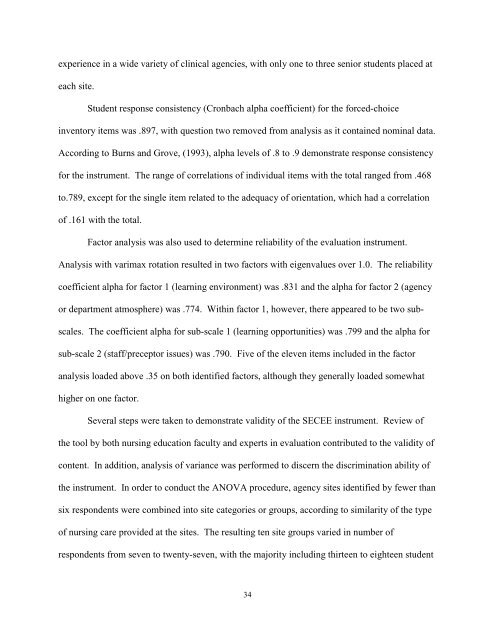STUDENT EVALUATION OF CLINICAL EDUCATION ENVIRONMENT
STUDENT EVALUATION OF CLINICAL EDUCATION ENVIRONMENT
STUDENT EVALUATION OF CLINICAL EDUCATION ENVIRONMENT
Create successful ePaper yourself
Turn your PDF publications into a flip-book with our unique Google optimized e-Paper software.
experience in a wide variety of clinical agencies, with only one to three senior students placed at<br />
each site.<br />
Student response consistency (Cronbach alpha coefficient) for the forced-choice<br />
inventory items was .897, with question two removed from analysis as it contained nominal data.<br />
According to Burns and Grove, (1993), alpha levels of .8 to .9 demonstrate response consistency<br />
for the instrument. The range of correlations of individual items with the total ranged from .468<br />
to.789, except for the single item related to the adequacy of orientation, which had a correlation<br />
of .161 with the total.<br />
Factor analysis was also used to determine reliability of the evaluation instrument.<br />
Analysis with varimax rotation resulted in two factors with eigenvalues over 1.0. The reliability<br />
coefficient alpha for factor 1 (learning environment) was .831 and the alpha for factor 2 (agency<br />
or department atmosphere) was .774. Within factor 1, however, there appeared to be two sub-<br />
scales. The coefficient alpha for sub-scale 1 (learning opportunities) was .799 and the alpha for<br />
sub-scale 2 (staff/preceptor issues) was .790. Five of the eleven items included in the factor<br />
analysis loaded above .35 on both identified factors, although they generally loaded somewhat<br />
higher on one factor.<br />
Several steps were taken to demonstrate validity of the SECEE instrument. Review of<br />
the tool by both nursing education faculty and experts in evaluation contributed to the validity of<br />
content. In addition, analysis of variance was performed to discern the discrimination ability of<br />
the instrument. In order to conduct the ANOVA procedure, agency sites identified by fewer than<br />
six respondents were combined into site categories or groups, according to similarity of the type<br />
of nursing care provided at the sites. The resulting ten site groups varied in number of<br />
respondents from seven to twenty-seven, with the majority including thirteen to eighteen student<br />
34












